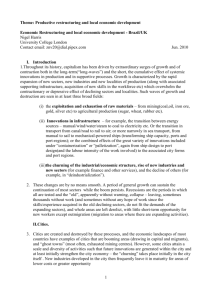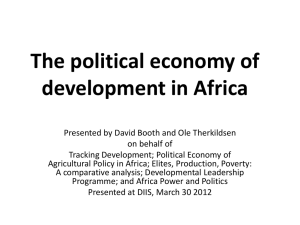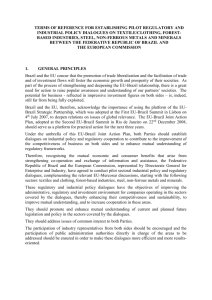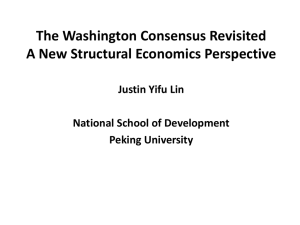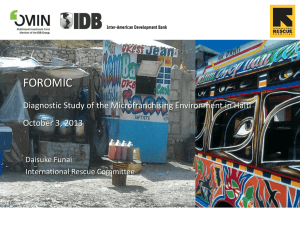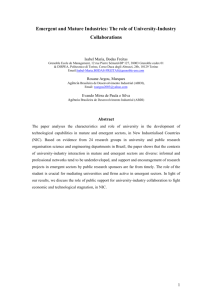Industrial Policy and development: Lessons from Brazil
advertisement
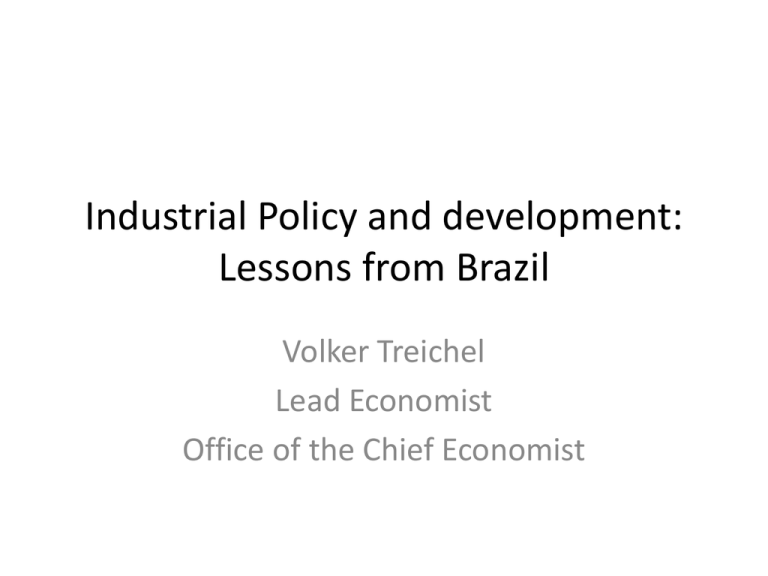
Industrial Policy and development: Lessons from Brazil Volker Treichel Lead Economist Office of the Chief Economist Brazil’s economic performance • Paper draws attention to Brazil’s remarkable economic performance over the past 10 years and discusses the role of industrial policy in this performance. • Growth during 2004-2010 doubled to an average of 4 percent from 2 percent during 1996-2003. • Poverty declined from 35 percent in 2000 to 22 percent in 2009. • Inflation declined from almost 15 percent in 2003 to an average of 3 to 5 percent during 2006-2010. Brazil’s industrial policy • Focus on both hard and soft industrial policy in the context of the Plano Brasil Maior • Tax incentives • Access to financing • Infrastructure • Education • Research and Development BNDES - Key role • Bigger than the World Bank in assets and disbursement • Crucial role in providing access to finance to key sectors • Key principles of cooperating with the private sector and of focusing on policy implementation But Brazil and LAC remain trapped in the middle-income status Figure 1: Ratio of Selected LAC Countries' GDP per capita to US GDP per capita (1990 International Geary-Khamis dollars) 1 0.9 0.8 0.7 Argentina 0.6 Brazil 0.5 Chile 0.4 Mexico Peru 0.3 LAC 0.2 0.1 1900 1903 1906 1909 1912 1915 1918 1921 1924 1927 1930 1933 1936 1939 1942 1945 1948 1951 1954 1957 1960 1963 1966 1969 1972 1975 1978 1981 1984 1987 1990 1993 1996 1999 2002 2005 2008 0 Source: Maddison (2010). Even though labor productivity has been rising… Figure 2 : Labor productivity in manufacturing (value added per employee, US$) 60000 China 50000 Brazil 40000 Mexico 30000 20000 10000 0 1990 Source: UNIDO (2011). 1992 1994 1996 1998 2000 2002 2004 2006 Lack of industrial upgrading is the problem Figure 3: EXPY Trends for Latin America, China, and India 20000 Costa Rica 18000 Mexico 16000 EXPY Argentina 14000 Brazil Chile 12000 Colombia 10000 China 8000 1991 1992 1993 1994 1995 1996 1997 1998 1999 2000 2001 2002 2003 2004 2005 2006 2007 2008 2009 2010 Source: World Bank calculations based on Comtrade. The Rise of China and LAC • China’s performance since 1979 – An average annual GDP growth rate of 9.9% – An average annual trade growth rate of 16.3% • The Opportunity and Challenge to LAC – China’s dynamic growth has contributed to a global resource boom, which benefits LAC – China became an important source of FDIs – China’s export of light manufacturing products causes some LAC countries to lose their light manufacturing sector Industrial Policy in a Market Economy • Industrial policy is a useful tool for the state to play the facilitation role. – Contents of coordination may be different, depending on industries. – The government’s resources and capacity are limited and need to be used strategically. • To be successful, the targeted industries should be in line with the economy’s latent comparative advantages. • But how to do it? 9 NSE and the Failure of Structuralism • Structuralism advised governments to develop industries that were too far advanced compared to their countries’ level of development and went against their comparative advantages. • The firms were non-viable in competitive markets and required government policy support for their initial investment and continuous operation. • This led to rent-seeking, corruption, and political capture. 10 NSE and the Failure of the Washington Consensus • All transitional economies started with many nonviable firms in their old priority sectors due to their comparative advantage-defying development strategy. • The Washington Consensus failed to recognize that the distortions were endogenous when advocating for the protection of nonviable firms in the priority sectors and advised the government to eliminate all distortions immediately, which caused the collapse of old priority sectors. • The Washington Consensus also opposed that government play a proactive role in facilitating firm entry into sectors consistent with the country’s comparative advantages. • The dynamically growing transitional economies adopted a dual-track approach: – The government continued to provide transitional support to nonviable firms in the old priority sectors and removed distortions only when firms in those sectors became viable or the sectors become very small. – The government facilitated private firms’ entry to sectors that were consistent with the country’s comparative advantage, which were repressed before the transition. 11 How to do it? • Selecting sectors that are in line with the country’s latent comparative advantage • Compensating first movers through subsidies and/or tax holidays • Lowering transaction costs through improved transportation and logistics, targeted skills development • Clusters of industries with similar profile. Concluding Remarks • Brazil has the potential to grow dynamically for decades, and to become a middle-income or even a high-income country in one or two generations, as long as the government has the right policy framework to facilitate the development of the private sector along the line of the country’s comparative advantages and tap into the latecomer advantages. • Industrial policy will contribute to Brazil’s effort to cope with the challenges and opportunities from the new world economy and help it break away from the middle-income trap and become high-income countries.


